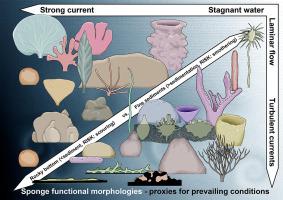Ecological Indicators ( IF 7.0 ) Pub Date : 2021-06-17 , DOI: 10.1016/j.ecolind.2021.107806 Christine Hanna Lydia Schönberg

|
The need to study sponge communities in comparatively inaccessible habitats led to a sponge classification system that relies on the strictly functional interpretation of traditional sponge morphologies. The aim is to deliver a standardised approach that can optionally be based on imagery and can be applied across all oceans and to any water depth. The system is designed to recognise community-level changes across time and space. The functional context allows a basic interpretation of environmental conditions and may thereby inform on the reasons for observed differences in prevailing morphologies. In terms of growth form sponges appear to respond most strongly to the flow regime and to sediments. Strong turbulent flow will favour low-relief, morphologically simple sponges that are often structurally reinforced and well attached, such as crusts and simple-massive forms. Laminar flow selects for two-dimensionally erect, vertically flattened, usually flexible sponges that are aligned broadside to the current, inhalant openings (ostiae) pointing upstream, and exhalant openings downstream (oscula). Flow strength is generally inversely related to number of erect sponges, to body height (except in globular sponges), oscular diameter, branch number and branch complexity. Where flow conditions reduce or limit access to water exchange and nutrients, sponges tend to separate in- and exhalants in cup-like forms, reach into the water column as erect and even stalked forms, and in cases of extreme nutrient limitation the community will consist predominantly of carnivorous sponges. Globular and fistular sponges are usually abundant where the substrate is dominated by sediments, and where sediment deposition or movement is high. Fine sediments will often exclude sponges with much horizontal surface area. Based on these insights, the proposed scheme uses four basic morphologies: functional 1 – crusts, 2 – massives, 3 – cups and 4 – erect sponges. These are further divided into sponges that function as 1 – true crusts, endolithic-bioeroding, and creeping sponges, 2 – simple-massive, globular massive, composite-massive, and fistular sponges, 3 – cups, tubes, and barrels, and 4 – one-dimensionally, two-dimensionally and three-dimensionally erect forms, stalked, and carnivorous sponges.
中文翻译:

无需分类:海绵功能形态告知环境条件
在相对难以进入的栖息地研究海绵群落的需要导致了海绵分类系统,该系统依赖于对传统海绵形态的严格功能解释。目的是提供一种标准化方法,该方法可以选择性地基于图像,并且可以应用于所有海洋和任何水深。该系统旨在识别跨时间和空间的社区层面的变化。功能上下文允许对环境条件进行基本解释,从而可以告知观察到的主要形态差异的原因。就生长形式而言,海绵似乎对流动状态和沉积物的反应最为强烈。强烈的湍流将有利于低浮雕、形态简单的海绵,这些海绵通常在结构上得到加强并且附着良好,例如地壳和简单块状形式。层流选择二维直立、垂直扁平、通常是柔性的海绵,它们与水流横向对齐,吸入口 (ostiae) 指向上游,呼出口 (oscula) 向下游。流动强度通常与直立海绵的数量、体高(球状海绵除外)、眼孔直径、分支数量和分支复杂性成反比。在流动条件减少或限制获得水交换和养分的情况下,海绵倾向于以杯状形式将吸入和呼出气体分开,以直立甚至茎状形式伸入水柱,在极端养分限制的情况下,社区将包括主要是肉食性海绵。在基质以沉积物为主的地方,球状和瘘管海绵通常很丰富,以及沉积物沉积或运动高的地方。细小的沉积物通常会排除具有大量水平表面积的海绵。基于这些见解,提议的方案使用四种基本形态:功能性 1 – 结壳,2 – 块状,3 – 杯状和 4 – 直立海绵。这些海绵进一步分为具有功能的海绵 1 – 真正的结壳、内石生物侵蚀和蠕动海绵,2 – 简单块状、球状块状、复合块状和瘘管海绵,3 – 杯状、管状和桶状,以及 4 – 一维、二维和三维的直立形态、有柄、肉食性海绵。3 – 杯子和 4 – 直立海绵。这些海绵进一步分为具有功能的海绵 1 – 真正的结壳、内石生物侵蚀和蠕动海绵,2 – 简单大块、球状大块、复合大块和瘘管海绵,3 – 杯状、管状和桶状,以及 4 – 一维、二维和三维的直立形态、有柄、肉食性海绵。3 – 杯子和 4 – 直立海绵。这些海绵进一步分为具有功能的海绵 1 – 真正的结壳、内石生物侵蚀和蠕动海绵,2 – 简单块状、球状块状、复合块状和瘘管海绵,3 – 杯状、管状和桶状,以及 4 – 一维、二维和三维的直立形态、有柄、肉食性海绵。











































 京公网安备 11010802027423号
京公网安备 11010802027423号